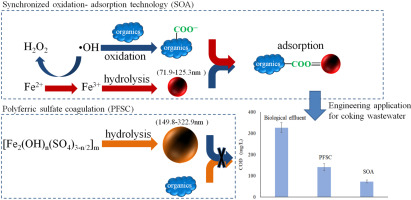当前位置:
X-MOL 学术
›
Water Res.
›
论文详情
Our official English website, www.x-mol.net, welcomes your
feedback! (Note: you will need to create a separate account there.)
Removal of hard COD from biological effluent of coking wastewater using synchronized oxidation-adsorption technology: Performance, mechanism, and full-scale application.
Water Research ( IF 11.4 ) Pub Date : 2020-01-23 , DOI: 10.1016/j.watres.2020.115517 Guangxi Sun 1 , Yu Zhang 2 , Yingxin Gao 3 , Xiaogang Han 4 , Min Yang 5
Water Research ( IF 11.4 ) Pub Date : 2020-01-23 , DOI: 10.1016/j.watres.2020.115517 Guangxi Sun 1 , Yu Zhang 2 , Yingxin Gao 3 , Xiaogang Han 4 , Min Yang 5
Affiliation

|
Efficient removal of the non-biodegradable organics from the biological effluent of industrial wastewater is becoming more and more important with the increasing demand for stringent discharge regulation. In this study, a synchronized oxidation-adsorption (SOA) technology was proposed for the removal of hardly biodegradable COD (hard COD) from the biological effluent of coking wastewater, and its performance was verified in a full-scale coking industrial park wastewater treatment plant (Q = 5,000 m3/d). The SOA was performed by coupling oxidation by hydroxyl radical (molar ratio of Fe2+ to H2O2 of 1:1 and pH = 5.0 ± 0.2) and adsorption by in-situ-formed nano hydrolyzed Fe3+ particles (nano-FeOOH). The nano hydrolyzed Fe3+ particles formed during the SOA exhibited a much higher specific surface area (22.83 m2/g) than the particles (10.87 m2/g) formed during the polyferric sulfate coagulation (PFSC). In comparison to PFSC, SOA performed better in terms of average COD removal (39% vs 18%) from the biological effluent. Wastewater fractionation result showed that SOA performed better in the removal of the hydrophobic acid matters, which was supported by the experiment using fulvic acid as the model organics. Mechanism studies using both biological effluent and fulvic acid solution showed that more carboxylic substances were adsorbed by the in-situ-formed nano-hydrolyzed Fe3+ particles formed by SOA than by PFSC, which was likely due to the generation of carboxylic substances by hydroxyl radical oxidation. In the full-scale, the COD was reduced from 118.5-198.0 mg/L in the PFSC-pretreated effluent to 61.5-104.0 mg/L through SOA treatment. The SOA treatment characterized with a mild pH condition (pH 5) and low molar ratio of Fe2+ to H2O2 (1:1) is particularly suitable for the polishing purpose to remove limited amount of organic pollutants from wastewater before discharge.
中文翻译:

使用同步氧化吸附技术去除焦化废水生物废水中的硬化学需氧量:性能,机理和全面应用。
随着对严格排放监管的需求不断增加,从工业废水的生物废水中有效去除不可生物降解的有机物变得越来越重要。在这项研究中,提出了一种同步氧化吸附(SOA)技术从焦化废水的生物废水中去除难生物降解的COD(硬COD),并在大型焦化工业园区废水处理厂中对其性能进行了验证。 (Q = 5,000立方米/天)。通过用羟基自由基(Fe2 +与H2O2的摩尔比为1:1,pH = 5.0±0.2)耦合氧化并通过原位形成的纳米水解Fe3 +颗粒(纳米FeOOH)进行吸附来进行SOA。SOA过程中形成的纳米水解的Fe3 +颗粒比颗粒(10.)具有更高的比表面积(22.83 m2 / g)。聚合硫酸铁凝结(PFSC)期间形成了87 m2 / g)。与PFSC相比,SOA在生物废水中的平均COD去除方面表现更好(分别为39%和18%)。废水分馏结果表明,SOA在去除疏水性酸性物质方面表现更好,这被富里酸作为模型有机物的实验所支持。使用生物废液和黄腐酸溶液的机理研究表明,SOA形成的原位形成的纳米水解Fe3 +颗粒比PFSC吸附的羧酸类物质更多,这很可能是由于羟基自由基氧化产生的羧酸类物质。全面而言,通过SOA处理,化学需氧量从PFSC预处理废水中的118.5-198.0 mg / L降至61.5-104.0 mg / L。
更新日期:2020-01-23
中文翻译:

使用同步氧化吸附技术去除焦化废水生物废水中的硬化学需氧量:性能,机理和全面应用。
随着对严格排放监管的需求不断增加,从工业废水的生物废水中有效去除不可生物降解的有机物变得越来越重要。在这项研究中,提出了一种同步氧化吸附(SOA)技术从焦化废水的生物废水中去除难生物降解的COD(硬COD),并在大型焦化工业园区废水处理厂中对其性能进行了验证。 (Q = 5,000立方米/天)。通过用羟基自由基(Fe2 +与H2O2的摩尔比为1:1,pH = 5.0±0.2)耦合氧化并通过原位形成的纳米水解Fe3 +颗粒(纳米FeOOH)进行吸附来进行SOA。SOA过程中形成的纳米水解的Fe3 +颗粒比颗粒(10.)具有更高的比表面积(22.83 m2 / g)。聚合硫酸铁凝结(PFSC)期间形成了87 m2 / g)。与PFSC相比,SOA在生物废水中的平均COD去除方面表现更好(分别为39%和18%)。废水分馏结果表明,SOA在去除疏水性酸性物质方面表现更好,这被富里酸作为模型有机物的实验所支持。使用生物废液和黄腐酸溶液的机理研究表明,SOA形成的原位形成的纳米水解Fe3 +颗粒比PFSC吸附的羧酸类物质更多,这很可能是由于羟基自由基氧化产生的羧酸类物质。全面而言,通过SOA处理,化学需氧量从PFSC预处理废水中的118.5-198.0 mg / L降至61.5-104.0 mg / L。











































 京公网安备 11010802027423号
京公网安备 11010802027423号